Human Spaceflights
![]()
International Flight No. 111STS-61CColumbia (7)24th Space Shuttle missionUSA |
 |
 |
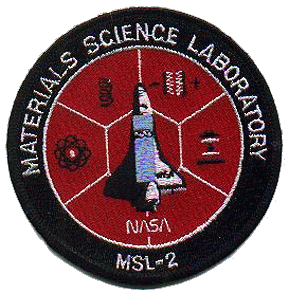 |
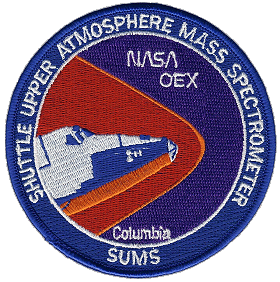 |
|
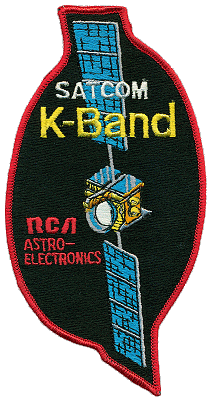 |
||
![]()
Launch, orbit and landing data
walkout photo |
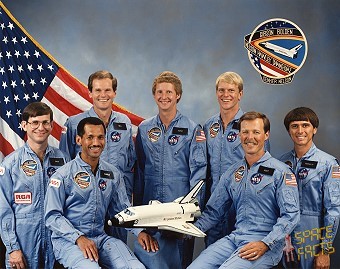 |
||||||||||||||||||||||||||||
alternative crew photo |
|||||||||||||||||||||||||||||
alternative crew photo |
Crew
| No. | Surname | Given names | Position | Flight No. | Duration | Orbits | |
| 1 | Gibson | Robert Lee "Hoot" | CDR | 2 | 6d 02h 03m 51s | 98 | |
| 2 | Bolden | Charles Frank, Jr. "Charlie" | PLT | 1 | 6d 02h 03m 51s | 98 | |
| 3 | Nelson | George Driver "Pinky" | MS-1, EV-1 | 2 | 6d 02h 03m 51s | 98 | |
| 4 | Hawley | Steven Alan | MS-2, FE | 2 | 6d 02h 03m 51s | 98 | |
| 5 | Chang-Diaz | Franklin Ramon | MS-3, EV-2 | 1 | 6d 02h 03m 51s | 98 | |
| 6 | Cenker | Robert Joseph, Jr. | PS-1 | 1 | 6d 02h 03m 51s | 98 | |
| 7 | Nelson | Clarence William, Jr. "Bill" | PS-2 | 1 | 6d 02h 03m 51s | 98 |
Crew seating arrangement
|
 |
|
||||||||||||||||||||||||||||||||
Backup Crew
|
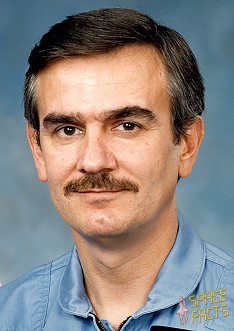 |
||||||||||
Hardware
| Orbiter : | OV-102 (7.) |
| SSME (1 / 2 / 3): | 2015 (5.) / 2018 (8.) / 2109 (9.) |
| SRB: | BI-024 |
| ET: | ET-30 (LWT-23) |
| OMS Pod: | Left Pod 04 (3.) / Right Pod 04 (3.) |
| FWD RCS Pod: | FRC 2 (7.) |
| RMS: | - |
| EMU: | EMU No. 1078 (PLSS No. 1005) / EMU No. 1081 (PLSS No. 1010) |
Flight
|
Launch from Cape Canaveral (KSC) and
landing on the Edwards
AFB, Runway
22. The launch was originally scheduled for December 18, 1985, but the closeout of an aft orbiter compartment was delayed, and the mission was rescheduled for the following day. However, on December 19, 1985, the countdown was stopped at T-14 seconds due to an out-of-tolerance turbine reading on the right SRB's hydraulic system. Another launch attempt, on January 06, 1986, was terminated at T-31 seconds because of a problem in a valve in the liquid oxygen system. The countdown was recycled to T-20 minutes for a second launch attempt on the same day, but was held at T-9 minutes, and then scrubbed as the launch window expired. Another attempt was made on January 07, 1986, but was scrubbed because of bad weather at contingency landing sites at Dakar, Senegal, and Morón, Spain; yet another attempt, on January 09, 1986, was delayed because of a problem with a main engine prevalve, and on January 10, 1986 heavy rainfall in the launch area led to another scrub. The main objective of this flight was to deploy the RCA's Satcom K-1 communications satellite, the second in a series of three, with its PAM D-2 upper stage. Satcom K-2 was deployed on flight STS-61B in November 1985. Also, aboard Columbia in the payload bay were the Materials Science Laboratory-2 (MSL-2); the first Hitchhiker payload; the RCA Infrared Imaging Experiment (IR-IE); and 13 Getaway Special Experiments in specializing canisters, 12 of which are mounted on a GAS bridge which was attached to the payload bay. Satcom K-1, the second of a planned fleet of three communications satellites operating in the Ku-band part of the spectrum, was deployed on flight day 1. The first, Satcom K-2, was carried aboard flight STS-61B in November 1985 and the third was scheduled for launch in 1987. Satcom K-1 was assigned to an orbital position of 85 degrees west longitude. Each of the spacecraft had 16 channels operating at 54 MHz usable bandwidth. The spacecraft were designed to provide coverage to the continental 48 states or to either the eastern half or western half. The three-axis stabilized spacecraft was equipped with power, attitude control, thermal control, propulsion, structure, and command ranging and telemetry systems necessary to support mission operations from launch vehicle separation through 10 years of operational life in geosynchronous orbit. This new generation of spacecraft carried 45-watt transponders, which permitted the use of Earth station antennas as small as 3 ft. (0.81 meter) in diameter. Because Ku-band frequencies are not shared with terrestrial microwave systems, antennas served by the satellites can be located within major metropolitan areas characterized by heavy terrestrial microwave traffic. The Satcom KU-band communications capability was provided by 15 45-watt traveling wave tube amplifiers for each of the 16 channels and six traveling wave tube amplifiers for redundancy. The 16 channels were set up in two groups of eight, each group contains three spare amplifier tubes. Each of the 16 channels used active frequency and polarization interleaving to permit the simultaneous use of each. The channels had a usable bandwidth of 54 MHz. The 4,144-pound (1,879 kg) RCA Satcom K-1 communications satellite was ejected from the payload bay on Flight Day 1. This was the second deployment of a spacecraft on the uprated D-2 model of the Payload Assist Module (PAM D-2). The PAM D-2 was instrumented with radio frequency telemetry which will downlink data to tracking aircraft during the burn of the solid rocket motor, a mission requirement for the first flight of a PAM-D2. This uprated, upper stage was identical to the PAM-D, except for size and weight. The spin-up was noticeably slower due to the larger mass and inertial components of the payload. PAM-D2 was designed to lift up to 4,200 lb. (1,905 kg) to geosynchronous orbit, compared to the 2,800-lb. (1,270 kg) PAM-D version. Also carried was a Materials Science Laboratory-2 structure for experiments involving liquid bubble suspension by sound waves, melting and resolidification of metallic samples and container-less melting and solidification of electrically conductive specimens. The following three experiments in the materials processing field were onboard: Electromagnetic Levitator (EML) - This experiment should study the effects of material flow during solidification of a melted material in the microgravity environment. Six samples will be suspended in the electromagnetic field of a cusp coil and melted by induction heating from the coil's electromagnetic field. Automated Directional Solidification Furnace (ADSF) - Consisting of four furnace/sample units, the experiment was designed to investigate the melting and solidification process of four different materials. Post flight, the samples were scheduled to be compared to samples of the same materials that were processed terrestrially. Three-Axis Acoustic Levitator (3AAL) - Twelve liquid samples were suspended in sound pressure waves, rotated and oscillated in a low-gravity, nitrogen atmosphere. Investigators wanted to study the degree of sphericity attainable and small bubble migration similar to that having to do with the refining of glass. EML and ADSF did not work and both experiments were cancelled. Only 3AAL worked without any problems. Columbia also carried a large number of small scientific experiments, including 13 Getaway Special (GAS) canisters devoted to investigations involving the effect of microgravity on materials processing, seed germination, chemical reactions, egg hatching, astronomy, atmospheric physics, and an experiment designed by Ellery Kurtz and Howard Wishnow of Vertical Horizons to determine the effects of the space environment on fine arts materials and original oil paintings. The objectives of the IR-IE were to acquire radiometric pictures/information of selected terrestrial and celestial targets. Contributed by RCA Communications and operated by Robert Cenker, the IR camera provided a ground field of view of approximately 27 by 21 n. mi. (50 by 38.8 km) at an orbital altitude of 160 n. mi. (296.3 km). A partial list of targets included the Aurora, volcanoes, zodiacal light, the moon, and the cities of Honolulu, Houston, Galveston, Miami and San Juan. Operating in the 2.5 to 3.0 and 3.5 to 4.2-micron bands, the instrument generated a television signal that was compatible with the existing CCTV video system onboard. The IR-IE was mounted on a standard pan/tilt unit in the C position of the payload bay (aft, starboard). Data collection were made on Flight Days 2 and 4 for approximately one hour each with a crew member stationed at the aft flight deck to operate the camera controls. All data were recorded on the video tape recorder. Spacelab Hitchhiker, a new payload carrier system which provided rapid and low-cost access to space, was carried on Shuttle mission STS-61C. Developed as a Shuttle payload-of-opportunity carrier, Spacelab Hitchhiker primarily accommodated science, technology and commercial payloads requiring rapid access to space on a standby basis, but having only limited pointing and onboard data processing requirements. The Hitchhiker system provided a payload support capability between those of payload carriers currently in use - the Getaway Special (GAS) and the Multiplexer/Demultiplexer pallet. Hitchhiker-G consisted of either two 50- by 60-inch (1.27 by 1.52 meters) aluminum plates or a single plate for mounting experiments and a GAS canister. It can accommodate four experiments having a total combined weight of 750 pounds (340 kg) or less. The aluminum plates and/or GAS canister was located on the starboard wall in the forward end of the orbiter bay. Hitchhiker-M was composed of a Multi-Purpose Experiment Support Structure pallet, a power control box and a Smart Flexible Multiplexer/Demultiplexer. Hitchhiker-M was limited to carrying three experiments having a total weight of 1,200 lb. (544 kg) or less. Like the Goddard Hitchhiker, no active cooling was provided. It had the same telemetry, power and command and control capability as Hitchhiker-G. The first Hitchhiker flight carrier (HG-1) contained three experiments: Particle Analysis Cameras (PACS) to study particle distribution within the Shuttle bay environment; coated mirrors to test the effects of the Shuttle's environment; and a Capillary Pump Loop (CPL) heat acquisition and transport system. The particle study, the coated mirror test and their avionics package will be mounted on a vertical plate attached to Columbia's starboard side. The pump loop experiment, which shares the same avionics system, will be mounted next to the plate inside a GAS canister. The objective of the Initial Blood Storage Experiment (IBSE) was to understand better the factors which limit the storage of human blood. The experiment attempted to isolate factors such as sedimentation that occur under standard blood bank conditions. A comparison was made of changes in whole blood and blood components which have experienced weightless conditions in orbit, with similar samples stored in otherwise comparable conditions on the ground. The blood samples were housed in four stainless steel dewars placed in two orbiter middeck lockers. With the exception of weightlessness, the conditions for both the flight samples and the control samples on the ground were intended to be like those in a standard blood bank. Specified temperature levels for the samples will be maintained by thermoelectric coolers. Finally, an experiment called the Comet Halley Active Monitoring Program (CHAMP), consisting of a 35 mm camera to photograph Comet Halley through the aft flight deck overhead window, was not successful because of battery problems. George Nelson changed the batteries but it seemed that CHAMP was damaged. Objectives of the CHAMP payload should include investigating the dynamical/morphological behavior as well as the chemical structure of Comet Halley. Photographic images and spectra should obtain through the windows of the orbiter crew cabin, using hand-held 35 mm camera and equipment. A crew member was scheduled to enclose himself in a camera shroud to eliminate all cabin light interference. Using International Halley Watch standard comet filters, several image-intensified monochromatic exposures were planned to made. In addition, spectra of the comet should be photographed with the aid of a grating and image intensifier. Congressman William Nelson became the second politician in space. He operated the Handheld Protein Crystal Growth (HPCG) experiment on mission STS-61C. The experiment continued the development and demonstration of techniques that use the weightless environment of space flight to produce protein crystals of sufficient size and quality to allow analysis of their nature and structure. Gravitational effects such as sedimentation have prevented the production of many such crystals in ground-based laboratories. The HPCG operations involved the use of four pieces of equipment to attempt the growth of 60 different types of crystals; 12 by means of dialysis and 48 via the vapor diffusion method. Additionally, William Nelson participated in 10 Detailed Supplementary Objective (DSO) studies for NASA's Space Biomedical Research Institute. These included studies of the physiological adaptation of the sensory-motor and cardiovascular systems as well as studies of fluid shifts, electrolyte changes and pharmacokinetics. The results from these studies provided additional insight into the effects of microgravity on the body's systems and were used in the development of countermeasures against the adverse aspects of physiologic adaptation. William Nelson also assisted mission specialist George Nelson in monitoring the operations of the Initial Blood Storage Experiment (IBSE). Significant modifications were made on orbiter Columbia in order to accommodate the following three research experiments developed by the Langley Research Center as part of the Orbiter Experiments Program (OEX). These experiments were designed to measure orbiter aerodynamic and aerothermodynamic characteristics during reentry. Shuttle Infrared Leeside Temperature Sensing (SILTS) - The SILTS package replaced the fintip atop the vertical tail and consisted of a cylindrical housing approximately 20 inches in diameter and is capped at the leading edge by a spherical dome. Mounted inside the dome is an infrared camera which obtained images of the upper (leeside) surfaces of Columbia's port wing and fuselage during reentry. The images provided detailed temperature maps at the surface of the leeside thermal protection materials and indicate the amount of aerodynamic heating of the surfaces in flight. SILTS will be activated by Columbia's computer at about 400,000 ft. (121.9 km) above Earth and were terminated after passing through the period of significant aerodynamic heating. Shuttle Entry Air Data System (SEADS) - Housed in a completely new nosecap, SEADS measured local surface air pressure through 14 penetration assemblies distributed about the nosecap's surface. Each assembly contained a small hole through which oncoming air passes. This experiment allowed precise post-flight determination of the orbiter's attitude relative to the oncoming airstream and the density of the atmosphere through which the vehicle has flown. SEADS was activated at an altitude of about 56 miles (90 km) through landing. Shuttle Upper Atmosphere Mass Spectrometer (SUMS) - Located inside the nose wheel well, SUMS sampled air at Columbia's surface through a small hole to measure the number of molecules of various gas species. It was planned to shorten the mission for one day, to have more time for maintenance work between the Shuttle missions, but bad weather in Florida forced to extend the mission duration about two more days. |
Photos / Graphics
 |
 |
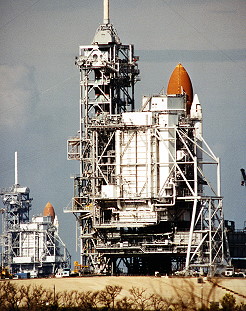 |
 |
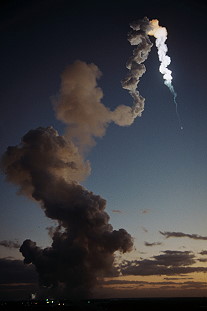 |
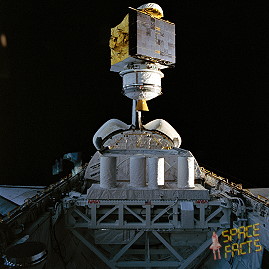 |
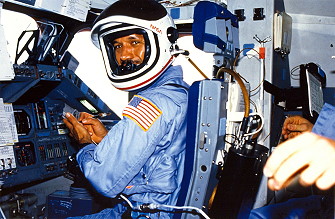 |
 |
 |
 |
 |
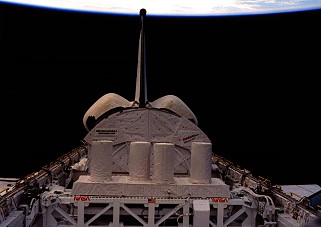 |
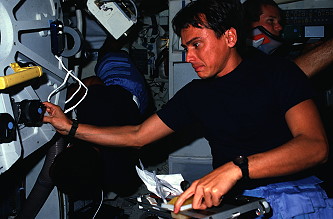 |
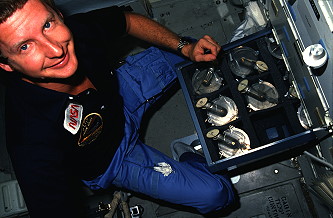 |
 |
 |
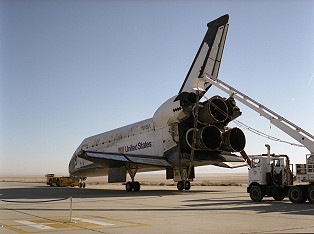 |
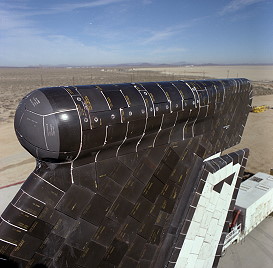 |
| © |  |
Last update on March 27, 2020.  |
 |